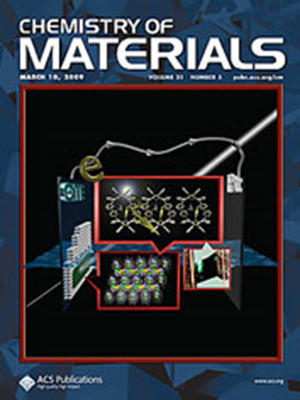近室温极性金属铁磁体中的d电子重费米子行为:以Mn5SiC为例
IF 7
2区 材料科学
Q2 CHEMISTRY, PHYSICAL
引用次数: 0
摘要
采用高温固相法合成了多晶Mn5SiC。Mn5SiC采用一种极性空间群(Cmc21),通过x射线和中子衍射、透射电镜以及二次谐波生成实验证实其具有6个晶体结构的Mn位。复杂的晶体结构具有边共享三角棱镜和二十面体,以及面/边共享五边形。磁测量表明铁磁性有序,转变温度为284 K。通过粉末中子衍射进一步确定了铁磁性结构(磁空间群Cm ' c ' 21),其中共线Mn自旋沿晶体c轴排列。在4 K下,每个Mn晶位的细化磁矩分别为1.8(2)、−2.42(9)、−1.72(8)、0.51(6)、0.50(4)和1.7(2)μB。密度泛函理论计算证实了实验观察到的金属行为和铁磁结构,并进一步深入了解了观察到的Mn力矩在晶体学位点上的依赖关系。电阻率和比热测量以及密度泛函理论计算表明,大的Kadowaki-Woods比为5 × 10-5 μΩ·cm/(mJ/mol)2,多体重整因子为5.5,表明在这种流动磁性金属中存在不寻常的重费米子行为。本文章由计算机程序翻译,如有差异,请以英文原文为准。
d-Electron Heavy Fermion Behavior in a Near-Room-Temperature Polar Metallic Ferrimagnet: A Case of Mn5SiC
Polycrystalline Mn5SiC was synthesized by using a high-temperature solid-state method. Mn5SiC adopts a polar space group (Cmc21) with six crystallographic Mn sites confirmed by X-ray and neutron diffraction, transmission electron microscopy, and second harmonic generation experiments. The complex crystal structure features edge-sharing trigonal prisms and icosahedra, as well as face/edge-sharing pentagonal prisms. Magnetic measurements indicate ferrimagnetic ordering with a transition temperature of 284 K. The ferrimagnetic structure (magnetic space group Cm’c’21) was further identified by powder neutron diffraction, where collinear Mn spins align along the crystallographic c-axis. The refined magnetic moment for each crystallographic Mn site at 4 K is 1.8(2), −2.42(9), −1.72(8), 0.51(6), 0.50(4), and 1.7(2) μB. Density functional theory calculations confirm both the metallic behavior and the ferrimagnetic structure observed experimentally and further provide insight into the observed Mn moment dependence across crystallographic sites. The resistivity and specific heat measurements and density functional theory calculations reveal a substantially large Kadowaki–Woods ratio of 5 × 10–5 μΩ·cm/(mJ/mol)2 and a many-body renormalization factor of 5.5, indicating the unusual heavy Fermion behavior in such an itinerant magnetic metal.
求助全文
通过发布文献求助,成功后即可免费获取论文全文。
去求助
来源期刊

Chemistry of Materials
工程技术-材料科学:综合
CiteScore
14.10
自引率
5.80%
发文量
929
审稿时长
1.5 months
期刊介绍:
The journal Chemistry of Materials focuses on publishing original research at the intersection of materials science and chemistry. The studies published in the journal involve chemistry as a prominent component and explore topics such as the design, synthesis, characterization, processing, understanding, and application of functional or potentially functional materials. The journal covers various areas of interest, including inorganic and organic solid-state chemistry, nanomaterials, biomaterials, thin films and polymers, and composite/hybrid materials. The journal particularly seeks papers that highlight the creation or development of innovative materials with novel optical, electrical, magnetic, catalytic, or mechanical properties. It is essential that manuscripts on these topics have a primary focus on the chemistry of materials and represent a significant advancement compared to prior research. Before external reviews are sought, submitted manuscripts undergo a review process by a minimum of two editors to ensure their appropriateness for the journal and the presence of sufficient evidence of a significant advance that will be of broad interest to the materials chemistry community.
 求助内容:
求助内容: 应助结果提醒方式:
应助结果提醒方式:


